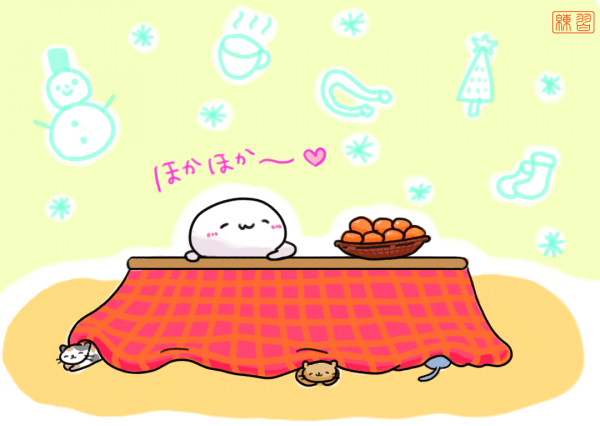At the time A

寒い時に炬燵に入るのは幸せです。
I'm happy when I get into (under) a kotatsu when it's cold.
22
其の時パレードが通り過ぎていった。
There was a parade going by at the time.
0
20
電話をして居る時に騒がないで!
Don't make noise when I'm on the phone!
0
19
他の人が遊んで居る時、彼だけは勉強して居た。
While the others were playing, he was the only one studying.
0
6
会社から帰って居る時に、大きな事故を見ました。
I saw a large accident when I was coming home from work.
0
4
子供の時ピアノを始めました。
I started piano when I was a child.
0
3
子供の時、東京に住んで居ました。
I lived in Tokyo when I was a child.
0
42
暇な時、何を為ますか?
What do you do in your spare time?
0
11
貴方は疲れて居る時も、老人に席を譲れますか。
Can you give up your seat to old people even when you are tired?
0
9
何時でも好きな時にいらっしゃい。
Come whenever you like.
0
8
お風呂に入って居る時、電話が鳴った。
When I was taking a bath, the telephone rang.
0
12
今朝起きた時、頭痛が為ました。
When I got up this morning, I had a headache.
0
1
其処へ着いた時には、店は既に閉まって居た。
When we arrived there, the store was already closed.
0
3
其の時ジョーンズさんが何か言い出した。
Mr Jones said something then.
0
8
其の馬は倒れた時に首を折って仕舞った。
The horse broke its neck when it fell.
0
Getting the sentences
Construction
(Elements in parentheses are optional.)
Basic Examples:
読む時 (when reading)
寒い時 (when it's cold)
若い時 (When (I was) young)
遅い時 (when (I'm) late)
子供の時 (When (I was) a child)
練習した時 (When (I) studied)
運転して居る時 (When (I'm) driving)
Related Expressions
最中
間/間に
際/際に/際は
間/間に
際/際に/際は
Where this grammar is found
Grammar usage notes
Verb A + 時, if the second clause of the sentence took place after Verb A, then Verb A is in the short past form (かった). If the second clause takes place during or before Verb A, then Verb A is in the present short form, regardless of overall tense of the sentence.
Three time relations exist between A and B:
- A and B take place simultaneously. (A=B)
- When A is completed, B takes place. (A->B)
- B takes place when A has yet to be completed. (B->A)
A's form determines how A and B are time-related.
B's form determines the overall tense of the sentence ('now').
Four combinations are possible:
#1. Verb A non-past 時、B non-past。(A=B, B->A)
#2. Verb A non-past 時、B past。(A=B, B->A)
#3. Verb A past 時、B non-past。(A->B)
#4. Verb A past 時、B past。(A->B)
Form #1:
日本へ行く時、飛行機で行きます。(A=B)
When I go to Japan, I will go by plane.
(Simultaneous.)
Form #2:
日本へ行く時、飛行機で行きました。(A=B)
When I went to Japan, I went by plane.
(Simultaneous.)
Form #1:
練る時、めざましどけいをかけます。(B->A)
When I go to bed, I set my alarm clock.
(I set my alarm clock before going to bed.)
Form #2:
練る時、めざましどけいをかけました。(B->A)
Same as above but past tense.
Form #3:
日本へ行った時、電話をします。(A->B)
When I get to Japan, I'll call you.
Form #4:
日本へ行った時、電話をしました。(A->B)
When I got to Japan, I called you.
- A and B take place simultaneously. (A=B)
- When A is completed, B takes place. (A->B)
- B takes place when A has yet to be completed. (B->A)
A's form determines how A and B are time-related.
B's form determines the overall tense of the sentence ('now').
Four combinations are possible:
#1. Verb A non-past 時、B non-past。(A=B, B->A)
#2. Verb A non-past 時、B past。(A=B, B->A)
#3. Verb A past 時、B non-past。(A->B)
#4. Verb A past 時、B past。(A->B)
Form #1:
日本へ行く時、飛行機で行きます。(A=B)
When I go to Japan, I will go by plane.
(Simultaneous.)
Form #2:
日本へ行く時、飛行機で行きました。(A=B)
When I went to Japan, I went by plane.
(Simultaneous.)
Form #1:
練る時、めざましどけいをかけます。(B->A)
When I go to bed, I set my alarm clock.
(I set my alarm clock before going to bed.)
Form #2:
練る時、めざましどけいをかけました。(B->A)
Same as above but past tense.
Form #3:
日本へ行った時、電話をします。(A->B)
When I get to Japan, I'll call you.
Form #4:
日本へ行った時、電話をしました。(A->B)
When I got to Japan, I called you.
If you would like to refer to a specific event such as "Time to sleep" or "Time to eat", you would use 「時間」(じかん) rather than 「時」.
For example, 食べる時間 would mean "Time to eat" while 食べる時 would mean "When (subject) eats".
The 間 binds the time-frame as an event in itself rather than just referencing the time.
For example, 食べる時間 would mean "Time to eat" while 食べる時 would mean "When (subject) eats".
The 間 binds the time-frame as an event in itself rather than just referencing the time.
Questions/Discussion
Nothing posted yet!